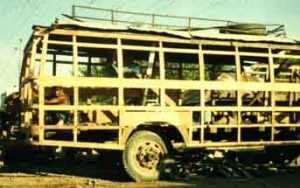
Car ownership is extremely rare in Bangladesh. In fact just having an adult bicycle in an extended family is a sign of some wealth. People do have other ways of getting around. One way to get to another town is by bus. I was a little taken aback when I saw carpenters make the frames of the buses out of wood. They do cover the frames with sheet metal and install windows and seats inside, so the buses look familiar when the bus is finished.
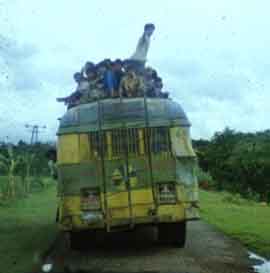
Some of the ways they actually ride the buses might not be so familiar. When the inside of the bus fills up, well, there’s still plenty of room on top. This picture should allay any lingering reservations about the strength of the wooden frames. I think there was a law about not riding on top, but it was only enforced in the capital city. When a big holiday was coming up, everybody would return to their home place. The buses then were completely covered with people—on top, on the sides, on back.
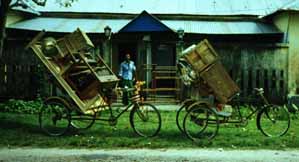 Tricycle rickshaws provided shorter-range transportation. The rickshaws driver was also the engine. Although primarily used to transport people, I have included a picture showing that the people are skilled at piling on and moving furniture as well. The topography of Bangladesh—no hills except on the fringes of the country—makes it well suited to rickshaws. I even saw a rickshaw school bus that held 6 young (privileged) kids.
Tricycle rickshaws provided shorter-range transportation. The rickshaws driver was also the engine. Although primarily used to transport people, I have included a picture showing that the people are skilled at piling on and moving furniture as well. The topography of Bangladesh—no hills except on the fringes of the country—makes it well suited to rickshaws. I even saw a rickshaw school bus that held 6 young (privileged) kids.
 There are many concrete bridges in Bangladesh that carry buses, but for the hundreds of thousands of small villages separated from the road by a canal, the people have to use a material they can afford: bamboo. I never heard of anyone slipping and falling in the water. I speculate that they are like gymnasts who use a balance beam from an early age. They become very good at it.
There are many concrete bridges in Bangladesh that carry buses, but for the hundreds of thousands of small villages separated from the road by a canal, the people have to use a material they can afford: bamboo. I never heard of anyone slipping and falling in the water. I speculate that they are like gymnasts who use a balance beam from an early age. They become very good at it.
I crossed one of these bridges to and from work every day if I took the shortcut. The difference was that instead of there being just one bamboo pole to walk on, there were two lashed together, so you could jam your feet in-between and not slip even in wet, slippery weather.
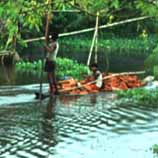 The cargo in this boat is bricks. Have you ever heard the expression, “Don’t rock the boat”? Literally how much can these guys rock the boat before it swamps and sinks like a ton of bricks? In every aspect of life it seems people in Bangladesh live on a knife’s edge, without a safety margin.
The cargo in this boat is bricks. Have you ever heard the expression, “Don’t rock the boat”? Literally how much can these guys rock the boat before it swamps and sinks like a ton of bricks? In every aspect of life it seems people in Bangladesh live on a knife’s edge, without a safety margin.
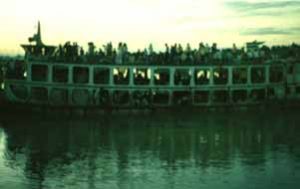 In Bangladesh, riverboats are still used to transport people. To visit projects in remote parts of the country I rode riverboats and felt some of the magic of the river. The stories about Tom Sawyer, Huckleberry Finn and life on the river came back to me with a new depth.
In Bangladesh, riverboats are still used to transport people. To visit projects in remote parts of the country I rode riverboats and felt some of the magic of the river. The stories about Tom Sawyer, Huckleberry Finn and life on the river came back to me with a new depth.
It was on the riverboats that the paradox of Bangladesh solidified. On one hand, Samuel Clemens (AKA Mark Twain) captured the nostalgia for a simpler time when kids could be free and active. They didn’t spend hours on end in front of TV and video games. Instead, they fished, hunted, hiked, helped out on the homestead and amused themselves. Kids in Bangladesh still live like that. Even girls, when they’re young. People had a greater awareness of nature and relied on religious faith more. Families, neighborhoods and traditions were more important. That’s still true in Bangladesh.
On the other hand, safety regulations were nonexistent and accidents on riverboats were common. Clemens’ brother died in one. All but one of Clemens’ children died in agony, of diseases that have now been eliminated in industrialized countries, but not Bangladesh. Twain noted glaring social injustices of his day. Child labor, illiteracy and gross scientific ignorance were widespread, which is still the case in Bangladesh. Social structures could be intolerant of diversity. Sometimes the good ol’ days weren’t.
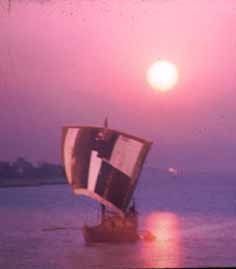 It’s a two edged sword, isn’t it? I don’t take the blessings of modern life for granted, having seen life without them. Aren’t we fortunate to have vaccines, education, swift transportation, food in abundance, the internet and so on? At the same time, I want to keep some old fashioned elements of life that will never be too old to be worth holding onto.
It’s a two edged sword, isn’t it? I don’t take the blessings of modern life for granted, having seen life without them. Aren’t we fortunate to have vaccines, education, swift transportation, food in abundance, the internet and so on? At the same time, I want to keep some old fashioned elements of life that will never be too old to be worth holding onto.
